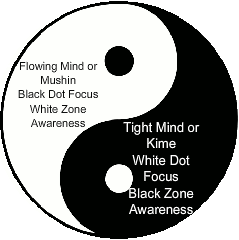Thrust
Snap
Whip
Slice
The four basic motions describe methods of execution which can be used to deliver many different techniques.
Thrusting refers to a method of execution where the weapon is delivered with penetrating force to the target. The intention is to deliver a significant amount of force deep into the target for the purpose of deep tissue or organ damage. While powerful, thrusting techniques shed energy as they continue to maintain contact with the target. Even though they may last only fractions of a second more than other strikes, the difference in energy transferrence is noticable. While they still may deliver the same amount of force as other methods of execution over time, by delivering that force over a greater period of time the acceleration of the weapon is diminished, resulting in less force being delivered within any specific instant. The trade off is that the force is delivered with greater penetration, and thrusting strikes can be used to reposition the opponent due to the dispersion of the force affecting a greater surface area.
Snapping techniques strike the target and then are immediately withdrawn, causing the force of the strike to be delivered at the surface of the target instead of deeper within. As a result, the same amount of force as a thrusting strike may be transferred, but it will occur much quicker and over a smaller surface area. By striking and withdrawing in this fashion, the force is delivered into the target before the target is able to react to the impact. This is what causes solid objects, such as wooden boards or bats, or more appropriately to a self defense approach, bones, to brake on impact. While bones have a very high degree of tensile strength when compared with concrete or carbon fiber, they require time to for elastic deformation to occur. This is what allows martial artists to break concrete slabs. Their bones experience elastic deformation and return to their approximate shape, while the concrete slabs experience plastic deformation which is irreversible. However, if the force can be transferred before the tissue has a chance to experience elastic deformation, even if the difference is only fractions of a second, the target may shatter instead of deforming, resulting in broken bones.
Whipping is a method of execution which relies on the conservation of momentum to apply great force at the termination of a strike. The law of conservation of linear momentum is a fundamental law of nature, and it states that the total momentum of a closed system of objects (which has no interactions with external agents) is constant. Until the point of termination the total amount of energy within a strike remains the same, however, momentum is the product of mass times speed (p=mv) or as Newton's Second Law states, F=ma. Because of this, as the mass of the weapon decreases, the acceleration of the weapon must increase in a corresponding fashion. This means that if a strike is launched with the body, by the point of execution the weapon will be traveling far faster than the body was originally. Although some of that energy will be lost along the way as natural muscle resistance, gravity, and air pressure act against the object, most of it will still be transferred into the opponent. This allows for weapons with a small amount of mass to be delivered with a great deal of speed, which upon hitting the greater mass of the target transfers much of the power with which they were originally launched into the opponent. Backnuckle strikes and finger flicks are examples of techniques which can benefit from whipping motions. Despite their relatively small mass, by coordinating the body with the strike they can deliver a large amount of force into the opponent.
Slicing techniques are those techniques which move past a target while maintaining contact with that target. Through a process called kinetic friction energy is transferred from the weapon to the target allowing for deformation of the contact surfaces. These kinds of techniques are often delivered to exposed vital areas where surface deformation could cause significant injury, such as the eyes, or where the slicing motion can be used to absorb some kinetic energy from an object in motion, such as a kick or punch, and redirect the rest, while dispersing the energy absorbed over a greater surface area in order to lesson the effect on the defensive weapon being used.
While many impact weapons can be delivered with each of these methods of execution, it is equally important to remember that defensive maneuvers and even stance transitions can take advantage of some of the properties of each of these methods of execution as well. Also, some Complex basics may incooperate combinations of methods as described above, resulting in a hybrid motion which has attributes of more than one of the four basic motions.
-Rob

